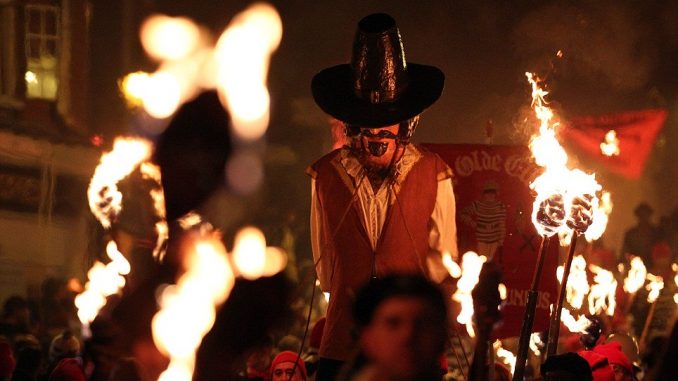
Catholic dissident Guy Fawkes and 12 co-conspirators spent months planning to blow up King James I of England during the opening of Parliament On This Day, November 5, 1605. But their assassination attempt was foiled the night before when Fawkes was discovered lurking in a cellar below the House of Lords next to 36 barrels of gunpowder. Londoners immediately began lighting bonfires in celebration that the plot had failed, and a few months later Parliament declared November 5 a public day of thanksgiving. Guy Fawkes Day, also known as Bonfire Night, has been around in one form or another ever since. Though originally anti-Catholic in tone, in recent times it has served mainly as an excuse to watch fireworks, make bonfires, drink mulled wine and burn Guy Fawkes effigies (along with the effigies of current politicians and celebrities).
Catholicism in England was heavily repressed under Queen Elizabeth I, particularly after the pope excommunicated her in 1570. During her reign, dozens of priests were put to death, and Catholics could not even legally celebrate Mass or be married according to their own rites. As a result, many Catholics had high hopes when King James I took the throne upon Elizabeth’s death in 1603. James’ wife, Anne, is believed to have previously converted to Catholicism, and his mother, Mary Queen of Scots, was Elizabeth’s Catholic archrival prior to being executed. There were even rumors, inspired by his diplomatic overtures to the pope, that James himself would become Catholic.
It soon became clear, however, that James did not support religious tolerance for Catholics. In 1604 he publicly condemned Catholicism as a superstition, ordered all Catholic priests to leave England and expressed concern that the number of Catholics was increasing. He also largely continued with the repressive policies of his predecessor, such as fines for those refusing to attend Protestant services.

English Catholics had organized several failed conspiracies against Elizabeth, and these continued under James. In 1603 a few priests and laymen hatched the so-called Bye Plot to kidnap James, only to be turned in by fellow Catholics. Another related conspiracy that year, known as the Main Plot, sought to kill James and install his cousin on the throne. Then, in May 1604, a handful of Catholic dissidents—Guy Fawkes, Robert Catesby, Tom Wintour, Jack Wright and Thomas Percy—met at the Duck and Drake inn in London, where Catesby proposed a plan to blow up the Houses of Parliament with gunpowder. Afterwards, all five men purportedly swore an oath of secrecy upon a prayer book.



Be the first to comment